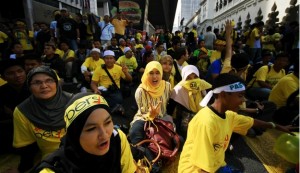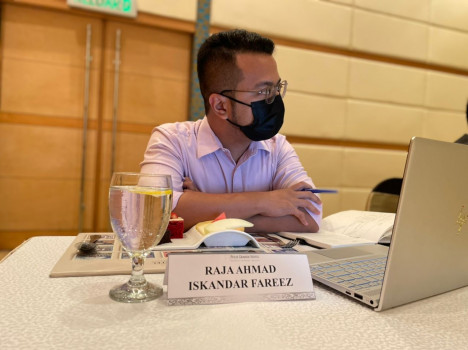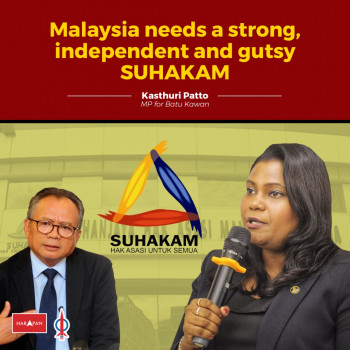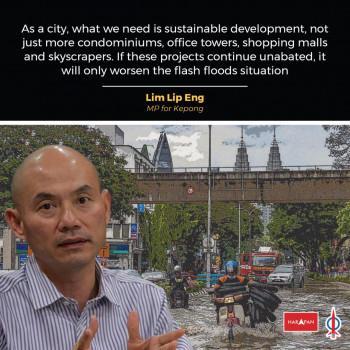by Tung Wan Qing
 The Peaceful Assembly Act (PAA) was introduced by Najib Razak in his Malaysia Day address on 15 September 2011. He announced the repeal of the repressive Internal Security Act (ISA) while replacing it with two new laws (including PAA), in order to reform and uphold human rights in Malaysia.
The Peaceful Assembly Act (PAA) was introduced by Najib Razak in his Malaysia Day address on 15 September 2011. He announced the repeal of the repressive Internal Security Act (ISA) while replacing it with two new laws (including PAA), in order to reform and uphold human rights in Malaysia.
The new PAA was said to give more freedom for the citizens to organize and participate in assembles peacefully and without arms, however with “necessary” restrictions and conditions applied in the interest of public order and security.
A year has passed, has our country moved forward as far as freedom and human rights is concerned? The facts speak for themselves. We are worse off under the PAA than before. In fact, the Act creates a false illusion of ‘freedom’, while our rights are slowly being siphoned away.
Different broth but the same old medicine
Many cried foul when the PAA was rushed through and passed within two months in Parliament without any public consultation.
The PAA introduced several new rules:
First, organizers of assemblies must notify the authorities in written notice 10 days in advance, with precise details about the time, duration, location, purpose and the identity of the organizers and all speakers.
There were no specific age restrictions before, but now assembly participants must be at least 15 years of age, children not allowed, and the organizers must be 21 years or older.
Previously, assemblies in motion, a procession or demonstration were permissible (although subject to regulation) under Section 27 of the Police Act, but now street protests in any forms are strictly prohibited.
Despite the criticism and outcry stirred in civil society, the mainstream media lauded the self-proclaimed reformist Najib for taking “the country’s constitutional democracy to a higher and more mature plane” (New Straits Times, 23 November 2011).
How Peaceful?
How peaceful can this PAA be when you have more police restriction and more advance notices needed to have a gathering? Bersih 3.0 was the first mass gathering after PAA came into force.
The result? The electoral rally was deemed illegal after a series of applications and rejections. While more than 200,000 people went on the street, the police failed their first test by turning the event that was totally peaceful with tear gases and water cannons, let alone the brutal beatings and arrest of demonstrators and even journalists just after the rally was dismissed.
One month later on 22 May 2012, PKR leaders Anwar Ibrahim, Azmin Ali, and Badrul Hisham Shaharin (Chegubard), were charged for participating in the protest which police said caused “chaos” in the capital.
It is clear that the naming of the Act as “Peaceful” is misleading, as it sends an illusion to the public that assemblies will be peacefully held under the protection of this Peaceful Assembly Act. But in fact the relabeling of the name did nothing to alter an arrogant authoritarian system that is corrupted to the core.
Before and after that PAA, it is business as usual for a government determined to crack down on freedom of assembly rather than safeguarding it.
More police power under Police Act 2.0
With great power, there is more room for abuse. The new act gives the police absolute power and discretion in public assemblies. As the only appointed enforcement body, the police have the power to interrupt, to disperse and to arrest anyone in any assemblies whenever “necessary”, without any warrant. Participants who brought children along are said to have committed an offence and therefore exposed to arrest.
Organizers and participants have the full responsibility to follow all the do’s and don’ts set by the police. Failure to do so is punishable by penalties up to RM20,000 – this is double the penalties in the Police Act.
A police permit is no longer required for mass assemblies under the new PAA that is replacing Section 27 of the Police Act. However as the police officers are expected to respond to the application within 12 days, they may impose any restrictions and conditions and reject the application for any non-compliance.
The applicants may appeal to the Minister within 4 days, and wait 6 days for the reply. If everything fails, you have to go through the whole process all over again.
And so we saw what happened in the 428 rally, where great power came with excessive abuse. Much as Najib intended to amend the Police Act 1967, the so-called forward-looking step seemed designed to turn Malaysia into a police state.
Give me liberty or give me death
As American independence fighter Patrick Henry famously said, “give me liberty or give me death”.
In fact, to discuss whether we are “freer” than before, or whether PAA has ensured “more freedom” to assemble is a bizarre concept. The right and freedom of assemblies are guaranteed in Article 10 of the Federal Constitution as well as in the International Human Rights principles. Any restricted freedom is a violation and defection of these enshrined principles.
Some people have argued that the re-enacted law has changed everything to be permitted unless prohibited, while previously it was the other way round. But the prohibitions are up to the police officer to define and judge without any third party to check and balance.
“Restrictions and conditions applied” would only provide gray areas that will cause nothing good for the citizens, but serve as loopholes for the authorities to take advantages and impose rules to certain groups at their wills, and let the other run rampant.
Unrestricted or absolute freedom does not mean that there is no consequence to bear if any individual threatens the public order or security in an assembly. Just the opposite, should the citizens be granted absolute freedom and full responsibilities for their behaviour and conduct, the country could then progress to a higher level of civilization with civil liberties and tolerance.
In short, there is no such thing as restricted freedom or controlling liberty. Grant everyone absolute freedom, or no freedom at all. Nothing in between is acceptable.
One Year Later…
PAA ensures no freer and healthier environment in upholding human rights as Najib promised. Given restricted freedom and controlling liberties in which the authorities have absolute power to monitor at will, we are worse off than previously.
There is nothing peaceful in this Peaceful Assembly Act, that name is but a window dressing term that reveals another example of the double speak of the Najib administration.
The 112 Himpunan Kebangkitan Rakyat was the first gathering that got approved not in the name of human rights, but due to internal political conflicts, huge public pressure and the approaching deadline to call for General Election.
With the assistance from mainstream media, the police claimed full credit for the peaceful turnout. It was the largest public assembly in the nation’s history since Tunku Abdul Rahman declared “merdeka” in the stadium of the same name.
Instead of lauding the participants’ discipline and good order, the organisers have been taken to task for three violations under the PAA. Their ‘crime’? (1) exceeding the maximum 30,000 crowd capacity allowed at Dataran Merdeka, (2) displaying banners that ‘incite’, and (3) having child participants. Clearly, the police missed the point.
However the truth is twisted, no one can deny that the event was peaceful without involvement by the state apparatus. If Malaysians have proven to the world that everyone can be well-disciplined in the spirit of democracy, why do we need the PAA in the first place? -The Rocket



